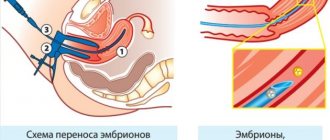Uterine bleeding with clots and heavy discharge during menstruation are often confused; women do not know the danger this pathology poses. Most women believe that this is a normal phenomenon and that this is how the body is cleansed. In fact, uterine bleeding not only spoils the quality of life, but is also dangerous to a woman’s health.
Unusual discharge in the form of uterine bleeding often occurs in women before menopause and in young girls during the formation of the menstrual cycle. During childbearing years, uterine bleeding is a deviation from the norm and indicates that something is going wrong in the body.
Description of the disease
Vaginal bleeding is the release of blood from the uterus. Most often it is a very serious symptom of pathologies in the female body. Any uterine discharge in the form of blood should be diagnosed in a timely manner, and the woman should receive medical care. Ignoring such symptoms leads to very dangerous consequences, and death is possible. It is important to know that normal vaginal bleeding includes only menstruation, the duration of which is five days, with stable breaks, the length of which is approximately twenty-eight days. Any other bleeding is considered a pathology and requires mandatory medical supervision. Now let's find out what are the reasons for this phenomenon.
How to provoke the onset of menstruation: folk methods
There are many folk remedies that can help induce menstruation when needed.
A well-known infusion of bay leaves causes contraction of the muscles of the organ. First, you need to think about the possible reasons for the delay and conduct a pregnancy test.
Tincture recipe: take a saucepan with 500 ml of water and 10 g of leaves, without closing the lid, boil for 10 minutes, pour into a thermos and leave for about 5 hours. Then cool and drink 4 times a day, 1 tbsp. l. Fragrant chamomile tea: you need to steam strong tea and drink half a glass 4 times.
The famous decoction of elecampane: it is considered quite effective, but at the same time a dangerous remedy. It can cause miscarriage and uterine bleeding. To prepare you need to take 1 tsp. root, pour 1 cup of boiling water, bring to a boil and cook for 10 minutes, leave for 5 hours. Drink 2 times a day, 1 tsp.
Also used:
- infusion of fresh dill and parsley;
- ginger root in the form of tea;
- infusion of onion peel;
- decoction of nettle and tansy;
- herbal mixture: mint, oregano and valerian.
Other supporting activities:
- Ascorbic acid - a “folk tale” that ascorbic acid helps induce menstrual periods. This also includes drinking lemon, but an excess of vitamin C is dangerous for the body and can lead to bleeding. In fact, it’s not worth risking your health for stupid attempts.
- Iodine – Some believe that drinking milk with added iodine will help induce menstruation. Do not forget that iodine, which is considered a toxic substance for the thyroid gland, can subsequently cause its inflammation and hormonal imbalance.
- A hot bath with honey or iodine and salt - in such a situation, the body may overheat, increasing the pressure and feeling faint.
- Sexual activity - often after a night of love, menstruation begins, this happens because the uterus contracts. Therefore, even masturbation can help in this situation.
- Excessive physical activity is a strong factor in the termination of pregnancy, causing menstruation. Of course, there are no specific exercises, but running, heavy lifting, long and bumpy rides can cause miscarriage.
As a rule, if the cause of the delay is not pregnancy, then it is likely that the problem is hormonal. This happens quite often if a woman exhausts herself with diets, fasting and intense physical activity. Herbs will not help here, you need to restore the body’s strength, take a course of vitamins and eat right.
What are the causes of the pathology?
Vaginal bleeding that is not associated with the menstrual cycle is called dysfunctional. This pathology often leads to unexpected blood loss in women of childbearing age. Up to ten percent of the fair sex suffer from time to time due to dysfunctional uterine blood loss. African American women suffer from this problem much more often.
What are the causes of bleeding from the uterus with clots should be determined by a doctor.
When hormonal reactions fail during menstruation, the levels of progesterone and estrogen change, leading to this phenomenon. This disorder is caused by a temporary imbalance of hormones and is not associated with disease. Dysfunctional uterine bleeding is diagnosed when any other causes of discharge from the genital tract (including trauma, tumors, specific diseases) are excluded.
In adolescence, as well as in adulthood, various reasons can lead to this pathology. Dysfunctional vaginal bleeding is associated with an anovulatory cycle, which does not result in the release of an egg. In some examples, this phenomenon occurs along with ovulation.
Even if a woman does not release eggs, hormonal uterine stimulation from estrogen continues. Progesterone, which is produced by the growing egg, is absent. Due to this, in this case, the inner walls of the uterus become unusually thick and increased in volume. Irregular shedding of the uterine mucosa often leads to significant bleeding.
The most common cause of vaginal bleeding in adolescents is anovulation. In the first two years after regular menstrual flow is established, approximately eighty-five percent of cycles occur without the release of an egg. As a teenage girl grows up, the number of anovulatory cycles turns out to be fewer, and regular menstrual periods appear more and more often. Six years after the appearance of regular cycles, only twenty percent of their number are anovulatory.
Types of discharge and their features
Depending on what phase of the cycle the spotting appears when taking oral contraceptives, the doctor can determine what the problem is and, if necessary, select a different drug.
At the beginning of the appointment
Sometimes minor bleeding appears in the first days after the end of menstruation, usually in the first month after starting to take contraceptives.
If the discharge does not stop after the end of the adaptation period, this may be a sign that the chosen contraceptive contains too little estrogen. In this case, you need to choose another drug after consulting your doctor.
At the end of the package
Continued bleeding at the end of the cycle indicates insufficient concentration of gestagen; this situation also requires a change in contraceptive.
If there is too much bleeding
Minor spotting should not cause concern to a woman; this side effect is mentioned in all instructions for taking oral contraceptives. But in some cases, bleeding between periods takes on a breakthrough character. If this is not associated with any pathologies, then this phenomenon is usually also associated with a period of adaptation of the body to changes in hormonal levels.
Heavy bleeding may be due to the increased effect of progestogens on the uterine endometrium; under their influence, it begins to atrophy ahead of schedule, provoking significant bleeding. The concentration of estrogen in oral contraceptives is very low, and they are not able to adequately perform a hemostatic function.
For more information on the causes of intermenstrual bleeding, watch this video:
Possible diseases
Possible diseases that can cause vaginal bleeding before menstruation include the following pathologies:
- Benign (that is, noncancerous) neoplasms of the reproductive organs.
- The presence of cancer of the vagina or cervix, as well as ovaries, can manifest itself as bloody discharge.
- Phenomena such as ovarian cysts, cervical inflammation, endometritis, fibroids, and vaginal infections can also provoke bleeding.
- Vaginal bleeding in patients over fifty years of age (after menopause) can be a serious concern due to the high likelihood of developing cancer. In addition, the vaginal mucosa can become thinner due to estrogen deficiency, which leads to bleeding during and after sexual intercourse.
How to distinguish vaginal bleeding from menstruation?
Doctors call bleeding excessive discharge in patients. You can determine them by counting the number of pads you change during the day. When you have to do this every hour, the gynecologist will confirm uterine bleeding.
Causes
JMC have a polyetiological origin and appear as a result of many factors, both external and internal. The most common cause of juvenile bleeding in girls is disruption of the reproductive system during the formation of the menstrual cycle. As a result of this disorder, the concentration of estrogen and progesterone changes, which causes uterine bleeding. Factors that provoke the appearance of juvenile uterine bleeding:
- blood diseases (including von Willebrand-Diana disease);
- heredity;
- excessive physical activity;
- strong emotional experiences and regular stress (problems at school, quarrels with parents or peers, etc.);
- vitamin imbalance in the body;
- chronic and acute infectious pathologies;
- disruption of the endocrine system;
- liver dysfunction.
JMC also depend on the physiology of a teenage girl. In the medical field, there are three types of disorders:
- hyperestrogenic: most often observed in children with psychological immaturity and excessive physiological and sexual development;
- normoestrogenic: occurs in young girls and adolescents with normal development and an underdeveloped uterus;
- hypoestrogenic: this type of disorder is encountered by young girls with a well-developed psyche, whose secondary sexual characteristics are poorly developed.
Treatment
Treatment of uterine bleeding depends largely on its causes and the age of the patient. Teenagers are often prescribed drugs that contract the uterus along with drugs that stop bleeding and strengthen the walls of blood vessels. It is also recommended to take vitamins along with herbal medicine, and less commonly, hormonal agents that regulate the menstrual cycle. Women of reproductive age are prescribed hormonal medications, and sometimes surgical operations are performed (in the presence of fibroids, uterine endometriosis, etc.).
After menopause, signs of vaginal bleeding mainly indicate oncological pathology of the uterus and ovaries, therefore therapy is required mainly of a surgical nature, which may also require removal of the uterus and its appendages. As part of treatment, it is most important to diagnose the cause of bleeding in time, so patients should seek medical help without delay.
Diagnosis of dysfunctional uterine bleeding
As mentioned earlier, dysfunctional uterine bleeding occurs without any organic pathologies, but against the background of hormonal imbalance. Therefore, diagnosis is based on excluding all diseases that may cause bleeding. This is called differential diagnosis, which is carried out with the following conditions:
- Ectopic pregnancy (cervical, tubal, ovarian) and miscarriage.
- Blood diseases (blood cancer, aplastic anemia, congenital and acquired bleeding disorders), which can lead to bleeding anywhere, including in the uterus.
- Polyps of the cervix and uterine body, endometrium.
- Benign neoplasms (uterine fibroids, endometriosis).
- Malignant oncological diseases (cervical cancer, endometrial adenocarcinoma).
- Inflammation of the pelvic organs (cystitis, salpingitis, endometritis).
- Ovarian tumors that produce estrogen.
- Systemic diseases (liver disease, thyroid disease, chronic renal failure).
Next, for diagnostics use:
- A general blood test, which shows signs of inflammation and anemia.
- Ultrasound diagnostics of the pelvic organs, where you can visualize polyps, inflammatory processes, relatively small tumors, and assess the thickness of the endometrium.
- Gynecological examination using vaginal speculum, which can also assess the condition of the genital organs, identify growths of the uterine mucosa and benign neoplasms (fibroids, polyps).
- Determination of sex and gonadotropic hormones using a blood test or special tests. To exclude diseases of the thyroid gland, the concentration of its hormones is assessed.
To identify blood clotting disorders, a biochemical analysis is used in the form of a coagulogram, which can be used to determine where the defect is located in the blood coagulation system.
If endometriosis is suspected, a biopsy of a pathologically changed area of the endometrium is used, and if cervical cancer is suspected, a cytological examination of a smear from the cervical canal is used.
Many girls with juvenile uterine bleeding have cysts in the mammary gland (fibrocystic mastopathy), so breast examination in such patients is mandatory.
Bleeding with clots: description
Women face various diseases of the genitourinary system. A common pathology is bleeding from the uterine cavity, which may be accompanied by the release of clots. Gynecologists use this term to refer to heavy discharge containing blood clots. This condition is very dangerous, and in serious cases leads to the death of the patient. Therefore, it is extremely important to determine the cause and treatment of uterine bleeding, which is accompanied by clots.
Exfoliated endometrial cells may come out with the blood. If the process takes place without pathologies, then the discharge will be homogeneous. If bleeding with clots occurs, we can conclude that the endometrium is unevenly exfoliated and the disease appears. When mucus comes out during this period, uterine bleeding is diagnosed, accompanied by clots.
Let's figure out how to stop vaginal bleeding.
First aid
Not all women experience such symptoms. Therefore, suddenly appearing blood can be frightening. It is logical that in this situation not everyone knows how to stop the release of blood with clots. But it is very important to do this as quickly as possible. Prolonged bleeding, which is accompanied by intense discharge, can lead to significant blood loss. The woman may experience anemia. In more serious situations, a coma along with death is observed.
This is why it is so important to know how to stop bleeding from the uterus with clots.
First aid must necessarily include several stages:
- The woman should lie on the bed and apply a heating pad with ice along with a cold compress to the lower abdomen.
- Legs are bent at the knees and slightly raised.
- Physical activity involving bending and lifting heavy objects is prohibited.
- In case of increasing bleeding or lack of positive dynamics, you should call an ambulance.
How can you stop the bleeding?
This can be done by using medication on your own. Traditional medicine also offers several recipes that help get rid of dangerous symptoms. To stop bleeding accompanied by clots, medications such as Etamzilat, Vikasol, Dicynon or Tranexam are usually taken.
Every woman should know how to stop vaginal bleeding.
Additionally, in case of pathological conditions, medications are used that lead to contraction of the uterine muscles. Among them, Pituitrin with Gifotocin stands out. Such drugs may not completely stop bleeding, but they significantly reduce the volume of discharge from the uterine cavity. The effect of the pills begins within half an hour after administration. In the event that acute blood loss is observed, oral medications are replaced with injectables. They lead to the desired result faster.
When do periods start after bleeding?
Today 58 d.c.... And I went to the doctor again, but let’s start from the beginning:
and so my last period started at the end of August, it was normal, during those periods I just had my hormones taken
But since work did not allow me to get to the doctor, until a crow pecked me in the ass, or rather, on the 28th day, a smear began, completely different from menstruation, scanty, and rather the discharge of ulcers mixed with blood continued for half a day for 5 days... I I wouldn’t call it menstruation at all, so I ran to the doctor! ultrasound at 31 d.ts in Argo (the doctor is an older man, I don’t remember his last name, it’s not written on the extract)
Of course, I didn’t really like the doctor in the World of Health (Kostroma) by the name of Antipova at first, but why not, as they say, I tried to trust her. After looking at the ultrasound and performing an examination, he prescribed me Dostinex (I end up taking Bergolak) 1 tablet per week (half a tablet 2 times per week). And supposedly wait for your period and start doing ovulation tests, they say folliculometry is still useless with such cycles, ultrasound and hormones, this of course confused me, because 5 good ovulation tests cost the same as 1 folliculometry, which is done 4 times per cycle. and the tests will have to be translated into a much larger amount. Well, okay, I bought Bergolak and started drinking. And now I’m on my 4th tablet, prolactin was in the middle of normal yesterday. But there are no periods.
I made an appointment with another doctor in Argo Kostroma. Voronina Tatyana Aleksandrovna is an older woman, but she didn’t remind me of an old-school doctor at all, she’s not rude and doesn’t rush to cut everything off at once (, remove it, prescribe OK there or urgently call for periods without being convinced of the reason for their absence.
She advised me a lot of things, firstly, to discard the idea of tests, and secondly, most likely, all the prolactin that the laboratory gave me was still low because only macro was elevated, take prolactin again tomorrow, see what it is like immediately after taking the pill and most likely the dose Let's reduce it to half a tablet per week. Secondly, the SG that we took at the Clinic of Andrology and Gynecology (Davydovsky district) was done according to the old standards, we need to take it according to the new ones in the DNA laboratory + sperm biochemistry, but it says most likely everything will be the same as normal, since the SG is still good, albeit old standards. I got an ultrasound by pure chance, because I didn’t have an appointment. Uzist Yarmolyuk (Argo clinic) agreed to stay late at work to do an ultrasound for me right away. And the ultrasound changed dramatically and I was ovulating and the uterus was no longer hypoplastic... Of course, I was impressed and again, this ultrasound specialist impressed me more than the man who did the ultrasound at 31 dc, a very attentive and neat, tactful, and outwardly pleasant girl!
I am very happy that I was ovulating, but nothing is clear to me about this cycle, of course)) Either this was a menstrual smear, but it didn’t look like it at all, it didn’t even look like bleeding, a smear in a word. Or perhaps Bergolak started the hormones to work) Or, after all, the ultrasound specialist at 31 d.c. intended something incorrectly or missed something. Tomorrow I’m going to take prolactin again, and after tomorrow I’m going to a second appointment with Tatyana Alexandrovna.
things like this...
Drugs
Your doctor may prescribe different medications to help stop the bleeding. They are taken orally or in injection form. Aminocaproic acid can be used internally up to five times a day. It is also allowed to inject it into a vein in the form of droppers. It inhibits the process of blood thinning in the human body. Due to its ability to increase clotting, the drug is not used for DIC syndrome.
Dicynon can be administered intramuscularly. It is also available in pill form, taken four times a day. The drug contains sodium ethamsylate, which quickly stops bleeding. The drug increases the level of platelets with their activity. It can be used for a long time, as it does not lead to increased clotting.
If profuse bleeding is observed, Tranexam is prescribed three times over four days. It has a pronounced hemostatic effect, as well as anti-inflammatory, antihistamine and antitumor properties. In case of simultaneous use with other similar drugs, there is a risk of blood clots. You can take Vikasol orally or intramuscularly for three days.
Ascorutin is taken orally for a week, which normalizes the condition of the vascular walls. Oxytocin is used to increase uterine tone. The drug is administered intramuscularly or in the form of droppers for a week. The hormonal product is made from the pituitary gland of cattle. The drug stimulates uterine contraction and constricts blood vessels. It is prohibited to use it with high blood pressure, against the background of thrombophlebitis and myocardial pathology. Oxytocin should absolutely not be used if you have uterine fibroids.
Vaginal suppositories should not be used for bleeding.
After uterine bleeding, when will your period start for the first time?
Author Maria Semenova Reading time 11 min. 03/12/2018
The usual menstrual cycle is a time period of 21-35 days. The duration of menstruation is from 3 to 7 days. All manifestations that do not fit within such a framework can be interpreted as pathology.
Most women have similar menstrual symptoms. As a rule, menstruation in the first days is in the form of slight discharge, which gradually increases. Towards the end, the discharge gradually decreases.
The bleeding is initially characterized by a bright scarlet hue. Then they change to brown or black, which, according to gynecologists, is the norm.
Help is also required in a situation when the woman herself is worried about: is the discharge menstrual or is it bleeding? In addition, the presence of pain should also be of concern.
What kind of blood discharge is considered normal?
During normal critical days, a woman secretes blood in average volumes per day (approximately 50 ml). The initial days of menstruation are characterized by bleeding of a pronounced color; later, the discharge acquires a more concentrated color and is released in parts.
The color of the blood released is also individual for a particular woman. Further discharge may occur when standing up or other sudden actions. In addition, mucus or blood clots appear in the mass of discharge. In parallel, the discharge has an odor similar to fresh blood or meat.
Normal periods
Symptoms that periods are normal:
- The time period after which normal periods begin is from 21 to 35 days. Each deviation in one direction or another requires additional research.
- Normal discharge lasts from 3 to 7 days. In some situations, longer menstrual flow (up to 10 days) is also not a symptom of pathology, but this must be determined by a doctor.
- From the start to the middle of critical days, the volume of released blood increases, then gradually decreases.
- The shade of discharge from deep red to brown , sometimes black, refers to a physiological phenomenon.
- The presence of clots of a browner hue indicates the detachment of fragments of the uterine epithelium during the process of its renewal. The absence of such clots should be of concern, as should their excessive appearance.
Not in all cases, the volume of bleeding over the entire period of critical days is equal to the average norm of 100 ml. If a completely filled sanitary pad needs to be changed at least once every 2 hours, such discharge is classified as heavy.
Heavy periods
There is an anomaly that every woman should know about - heavy menstruation. Their main difference from the norm is their regularity (they occur at the same time interval), but the total volume of blood loss is higher than normal.
This may be normal, but it is still necessary to visit a specialist. The bottom line is that heavy menstruation is often a sign of pathology. This is like a warning signal about the formation of a pathological process.
Deviations that contribute to the appearance of heavy periods include:
- Pathological growth of the endometrium.
- Uterine fibroids.
- Polyps on the reproductive organs.
- Uterine infectious lesions in a chronic state.
- Frequent abortions.
- Deviations in the position of the uterus (anteflexion, retroflexion, bends and septa).
- Systemic pathologies of blood coagulation.
In order to normalize bleeding during menstruation, the underlying disease should be cured, if possible.
Dysfunctional uterine bleeding
In this situation, the factors for uterine bleeding are loss of balance of female hormones, psychological difficulties, termination of pregnancy, taking hormone stimulants, and poor nutrition.
If we consider the physiological formation and aging of a woman’s body, the conclusion becomes obvious - dysfunctional bleeding appears in young girls and women in the premenopausal period. This is due to a disorder in the functional capabilities of the ovaries, which change during this period.
Causes
The main factors for the occurrence of bleeding are the following:
- termination of pregnancy, whether voluntary (abortion) or involuntary (miscarriage);
- if the birth of the child was accompanied by a caesarean section;
- frequent diets that lead to poor health;
- difficulties with the general hormonal picture, acute imbalance;
- lack of iron and vitamins;
- blood diseases;
- changes in blood coagulation;
- prolonged depression, stress;
- infectious lesions;
- heavy physical activity and lifting and carrying heavy objects;
- inflammation of the reproductive system;
- gynecological abnormalities;
- cancerous tumors.
Source: https://atlantstroy116.ru/posle-matochnogo-krovotechenija-kogda-pojdut-mesjachnye-v-pervyj-raz/
Surgery
In severe situations, bleeding can only be eliminated surgically. Women may undergo curettage of the cervical canal and uterine cavity. This allows you to quickly stop bleeding. The method is used both for patients of reproductive age and for menopause.
Liquid nitrogen can be used during therapy. In the process of cryodestruction, the upper uterine layer is destroyed by cold. The procedure is effective and is suitable for patients of any age. In endometrial ablation, the top layer of the uterus is removed. The procedure is carried out using a laser, loops, electromagnetic energy and a ball-shaped electrode. As a result of various effects, endometrial evaporation is carried out. It is worth remembering that such treatment is prohibited for nulliparous women.
Bleeding before menstruation
Vaginal bleeding can be a manifestation of various conditions (both serious and not posing any threat to health). Everything largely depends directly on the time of bleeding (for example, discharge after sexual intercourse and before menstruation are completely different things that may have nothing in common with each other).
The beginning of the menstrual cycle, as a rule, coincides with a decrease in the level of female hormones (estrogen and progesterone), as a result of which the mucous membrane of the uterine body (endometrium) begins to be shed, which leads to bleeding. The process of such rejection itself begins a couple of days before menstruation, which may be accompanied by minor bloody discharge. The blood has a lighter shade than menstrual blood. Diseases that lead to bleeding before menstruation:
- Presence of metabolic syndrome.
- The appearance of cervical polyps.
- Development of cervical cancer.
Thus, minor spotting three days before the start of the cycle can be considered normal. But when bleeding continues for more than four days, you should definitely consult a gynecologist. You need to monitor any changes in your health and be vigilant.
Signs of bleeding from the uterus
To know when to sound the alarm, it is important to recognize bleeding. Very often it is confused with a natural physiological process; the signs of pathology are very similar. Few people know how much blood they lose during menstruation, and it can be very difficult to see a significant difference.
In order to understand whether the discharge is heavy and whether it can be attributed to bleeding, you need to try to estimate the amount of fluid. This is done using personal hygiene products. If a pad or tampon is completely wet within an hour, this means it is not just menstrual flow, but dangerous uterine blood loss.
The duration of such manifestations cannot exceed a week and if blood loss increases, you should immediately consult a doctor. A blood clot in the uterus can take a long time to form, so it is important to pay attention to other symptoms.
Other signs of pathological discharge include:
- the appearance of small clots;
- severe pain in the lower abdomen of various types;
- unexplained weakness;
- nagging pain in the lower back;
- pallor of the skin.
Large blood loss leads to iron deficiency anemia, which is manifested by a decrease in hemoglobin in the general analysis after 2-3 days of heavy discharge.
Why does bleeding occur after menstruation?
The causes of such bleeding are very different. This could be a hormonal imbalance, various pathologies, and not only gynecological ones. It is also necessary to take into account the woman’s age, that is, the difference in physiology at different periods of life. Each age has its own reasons for the appearance of spotting after menstruation. Among the main ones it is worth highlighting the following:
- Diseases of the genital organs, characterized by an inflammatory nature.
- Taking or stopping oral contraceptives.
- Presence of endometriosis.
- The appearance of cervical diseases.
- The occurrence of benign as well as malignant tumors of the genital organs.
- Use of an intrauterine device.
- Ovarian dysfunction.
- Carrying out gynecological operations.
- Reduced thyroid function.
- The body's susceptibility to stress.
Now you know information about vaginal bleeding. Most often, these are quite a serious symptom of pathologies in the female body. Any uterine bleeding should be diagnosed in a timely manner, and the woman should receive medical care. Self-medication and waiting for everything to go away on its own are unacceptable.
We looked at the causes of vaginal bleeding and treatment.
Description of the pathological process
Vaginal bleeding is considered abnormal if it is in no way associated with normal menstrual bleeding. The pathology can be of varying intensity - from spotting and minor discharge to heavy bleeding between menstruation.
Reasons for development
Profuse bleeding can occur due to various negative factors. The most common reasons for the development of this condition include:
- Hormonal changes. They occur due to uncontrolled or long-term use of certain types of medications, as well as due to thyroid disease.
- The period after childbirth. Bleeding occurs with muscle weakness (uterine hypotonicity), with placental remnants or an inflammatory process in the uterine area.
- Ectopic pregnancy. Bleeding occurs due to a rupture of the fallopian tube.
- Abortion. Pathology can develop due to hormonal imbalance and disruption of the integrity of the uterus, as well as if infection and subsequent inflammation occurs.
- Diseases of the uterus and liver. Diseases of benign and malignant nature.
- Blood clotting disorders. With poor clotting, bleeding during menstruation does not go away for a long time. Heavy and prolonged periods, nosebleeds, bruises in different parts of the body are symptoms of low coagulation.
- Stress and emotional overstrain. These factors negatively affect the general condition of the body, which leads to hormonal imbalance and malfunctions of internal organs and systems.
Uterine bleeding is a profuse discharge of blood from the vagina. The pathology is dangerous because significant blood loss threatens the development of serious conditions.
It is worth noting that profuse bleeding is not an independent disease, but is one of the symptoms that indicate problems in the female body.
Clinical picture
Sharp and severe pain are clear signs of this pathological process. Bleeding often appears during menstruation, so the negative condition goes unnoticed by women. You should immediately consult a doctor for help with the following symptoms:
- Uncharacteristic prolonged and heavy menstruation. The volume of discharge exceeds 80 ml.
- Spotting between menses. Women often perceive this phenomenon as an early onset of the cycle.
- An unstable menstrual cycle, which is characterized by alternating heavy and scanty discharge.
- During menopause, reproductive function declines. The occurrence of bleeding during menopause may indicate the presence of cancer.
- Discharge of blood after sexual intercourse.
It is very important to consult a doctor in a timely manner, since even scanty spotting may indicate the growth of tumors. There are a number of common symptoms:
- dizziness, general weakness, fainting;
- vomiting, nausea;
- pale skin;
- tachycardia or bradycardia;
- low blood pressure.










